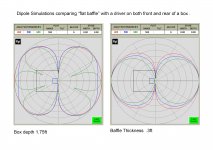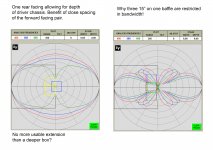Dipoles! Perhaps someone could help me with something I've been struggling to understand?
It's clear with a simple baffle that level will drop around 6dB/octave as cancellation occurs dependent on baffle size.
Now take the situation of a box with a driver on the front and back, the rear driver in reversed polarity. No pressure change inside the cabinet will allow the drivers to extend down to their fs. Their Qts could be managed or increased by either adding series R or placing a baffle between the driver internally with an acoustic resistance?
So cancellation between the rear of the drivers is avoided and the "transmission line" distance between them will limit the usable frequency response. The polar response is easily plotted with simulation programmes...
But. Finally. Here's my question!! Clearly there will now be a delay between the wave travelling around the cabinet to cancel with the rear driver so how is it possible to predict the bass frequency response given the driver implementation is now different to the flat baffle example. Am I getting close thinking it's now equivalent to the front baffle width + 2 x half (1 x full cabinet depth!) the cabinet depth? But of course that doesn't take into account the delay time between the drivers due to horizontal separation....or does it !! Confused!
It's clear with a simple baffle that level will drop around 6dB/octave as cancellation occurs dependent on baffle size.
Now take the situation of a box with a driver on the front and back, the rear driver in reversed polarity. No pressure change inside the cabinet will allow the drivers to extend down to their fs. Their Qts could be managed or increased by either adding series R or placing a baffle between the driver internally with an acoustic resistance?
So cancellation between the rear of the drivers is avoided and the "transmission line" distance between them will limit the usable frequency response. The polar response is easily plotted with simulation programmes...
But. Finally. Here's my question!! Clearly there will now be a delay between the wave travelling around the cabinet to cancel with the rear driver so how is it possible to predict the bass frequency response given the driver implementation is now different to the flat baffle example. Am I getting close thinking it's now equivalent to the front baffle width + 2 x half (1 x full cabinet depth!) the cabinet depth? But of course that doesn't take into account the delay time between the drivers due to horizontal separation....or does it !! Confused!
"So cancellation between the rear of the drivers is avoided"... is it here that there might be a misconception? If you think about it - the box and an other driver as a lumped entity just represent basically a driver with a very deep cone and a thicker baffle - right!? So the cancellation between front and back is still going on. Yes, the thickness might lower the cancellation point a bit due to the increased path distance between the drivers - equivalent to widening the baffle in your original problem definition.
How about that?
//
How about that?
//
"So cancellation between the rear of the drivers is avoided"
Are you talking about what's happening inside the box?
As for your question, it seems you just need to measure the path length.
Electro-acoustic models
Are you talking about what's happening inside the box?
As for your question, it seems you just need to measure the path length.
Electro-acoustic models
Same old fantasy about front waves annihilating the rear waves like in the textbook.
In the real world a whole of mixing and matching, support at one freq and reduction at another and all around the different path lengths and reflection paths and as the music plays.
The age of point-source stereo is passing. Now people want room filling ambience, just like in real concert halls that have almost no directionality*.
B.
* when your eyes are closed
In the real world a whole of mixing and matching, support at one freq and reduction at another and all around the different path lengths and reflection paths and as the music plays.
The age of point-source stereo is passing. Now people want room filling ambience, just like in real concert halls that have almost no directionality*.
B.
* when your eyes are closed
I posted a reply some time ago to TNT but it hasn't appeared here. I know what's going on inside the box...no pressure change! The reason I chose a box example was because the rear radiation from the cone is not being used and being in push/pull non linear distortions will cancel. I appreciate this will reduce efficiency compared to a flat baffle but it will also reduce the problems of flat baffle resonances. In dipole configuration there will be little stored energy in the box?
But TNT has it right. I am guessing then my assumption was correct and if you "unfold the box" the baffle size equivalent is the width of the baffle + 2 x half the cabinet depth?
The upper limit of frequency response is reduced when compared to a flat baffle due to the transmission line distance between the two divers but the benefits of the rigidity of the box and more domestically compatible shape might suit some?
But TNT has it right. I am guessing then my assumption was correct and if you "unfold the box" the baffle size equivalent is the width of the baffle + 2 x half the cabinet depth?
The upper limit of frequency response is reduced when compared to a flat baffle due to the transmission line distance between the two divers but the benefits of the rigidity of the box and more domestically compatible shape might suit some?
I've wondered about the transmission line between the cones as SL mentions. How is it different to a sealed box?
That's showing the polar response of the ripples above the dipole peak due to different path lengths. Isn't SL referring to the transmission line effect between the cones inside the box?
Yes. May be?? But there will be no pressure change inside the box though resulting in negligible cabinet energy storage and minimised non linear driver distortion.
The identical drivers would have the same excursion and would move at the same time, T=0, so there is no "delay" between them. I can't see how you can have a "transmission effect" inside the cabinet..unless someone can explain it to me.!!
The identical drivers would have the same excursion and would move at the same time, T=0, so there is no "delay" between them. I can't see how you can have a "transmission effect" inside the cabinet..unless someone can explain it to me.!!
He says: "Since the two cones move back and forth in unison, there is little air pressure inside the enclosure b at very low frequencies. When the internal length L becomes half wavelength, there is a sharp resonance of the transmission line between the cones, causing a severe dip and peak irregularity in the frequency response."
Here: Electro-acoustic models
Do dipoles for home theatre use share the cabinet?
Here: Electro-acoustic models
Do dipoles for home theatre use share the cabinet?
OK.. partition the cabinet into triangular sections. One for each driver and connect them with an acoustic resistance.That eradicates the problem of half wavelength interference and enables one to manage the Qts as well 🙂
I don't see the problem, the drivers can be close which would raise the frequency, then use damping to reduce the wave. I'd like to see proof it's an issue.
Yes, that would work too. Not such a convenient shape if you are going to mount mid cabinets or horns on top!
Here's one I did earlier 🙂 Yes, you can use a "less deep" cabinet (Baffle) as long as the forward pair are close together, but you will also suffer an spl loss..see first diagramn posted yesterday. What you can't do if you want extended frequency response is put three in vertical alignment.
There are some tweaks to achieve extended response and these include delaying the middle one of the three on the flat baffle or offsetting it horizontally, which defeats the object of the exercise. Plus my original observation, its very hard to make a large baffle non resonant..
There are some tweaks to achieve extended response and these include delaying the middle one of the three on the flat baffle or offsetting it horizontally, which defeats the object of the exercise. Plus my original observation, its very hard to make a large baffle non resonant..

